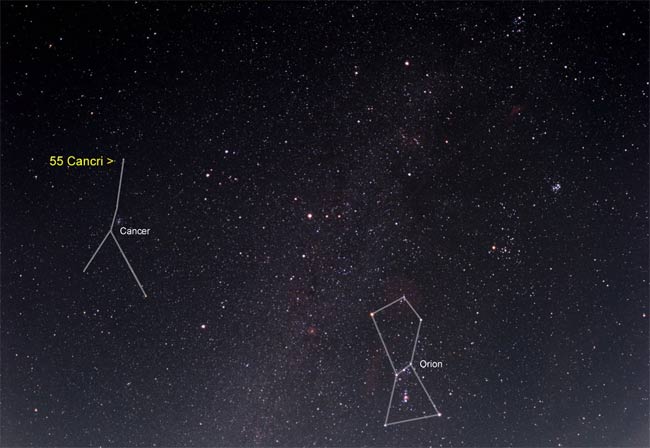
Scientists announced today the discovery of a fifth planet in a distant star system that now looks like a "cousin" to our own.
Known as 55 Cancri, the sun-like star harbors the most number of planets ever discovered outside our solar system.
"We now know that our sun and its family of planets is not unusual," study team member Geoffrey Marcy of the University of California, Berkeley told reporters in a teleconference.
Four of the planets had been previously detected, but the existence of the fifth planet took 18 years to confirm. It is about 45 times more massive than Earth and might be similar to Saturn in its composition and appearance.
55 Cancri is located 41 light-years away in the direction of the constellation Cancer and is visible with binoculars. The system contains a clutch of four inner planets that are separated from an outer planet by a huge gap.
"We haven't found a twin of our solar system, because the four planets close to the star are all the size of Neptune or bigger," Marcy said.
Although more than 250 extrasolar, or "exoplanets," are now known, only one other star, mu Ara in the southern sky, is known to have four planets. Astronomers expect many multi-planet star system to be found as technology improves.
Get the Space.com Newsletter
Breaking space news, the latest updates on rocket launches, skywatching events and more!
Possibly habitable
The newest member of Cancri 55's family lies within the star's habitable zone, the region around the star within which water can exist in its liquid state. Though the planet is a giant ball of gas, liquid water could exist on other, currently undiscovered rocky planets in the system. Marcy said he's optimistic that continued observations will reveal a rocky planet around the star within five years.
Such a potentially habitable planet could reside in the nearly 700 million-mile (1.1 million-kilometer) wide space that separates 55 Cancri's four inner planets and its outer one.
"I would bet you that gap isn't empty," said study team member Debra Fischer of San Francisco State University. "What we see in our solar system is that we are full up on planets. There are very few tiny windows where you can drop even a moon-sized object in and have it survive in a stable orbit.
Another possibility is that a moon in orbit around 55 Cancri's newly confirmed planet could harbor liquid water, and perhaps life, the researchers say
"If there were a moon around this planet, it would have a rocky surface," Marcy said. "Water on it could in principle puddle into lakes and oceans, serving as the solvent for biochemistry.
'One small step'
Michael Briley, an astronomer at the National Science Foundation who was not involved in the study, said the discovery marks an "exciting step" in the search for worlds like our own
"To go from the first detections of planets around sun-like stars to finding a full-fledged solar system with a planet in a habitable zone in just 12 years is an amazing accomplishment and a testament to the years of hard work put in by these investigators," Briley said
Alan Stern, associate administrator for the Science Mission Directorate at NASA headquarters in Washington who also was not involved in the study, said "it is amazing to see our ability to detect extrasolar planets growing.
"We are finding solar systems with a richness of planets and a variety of planetary types comparable to our own," Stern said
The planets were found using the Lick Observatory and the W.M. Keck Observatory in Hawaii using the so-called radial velocity, or "wobble," technique, whereby the presence of planets are inferred by the way they gravitationally affect their parent star's orbit. The newest world will be detailed in an upcoming issue of Astrophysical Journal.
"Finding five extrasolar planets orbiting a star is only one small step," Marcy said. "Earth-like planets are the next destination."
- Video: Alien Habitable Zone
- Video: Journey to a Planet-Rich Star
- Top 10 Most Intriguing Exoplanets
Join our Space Forums to keep talking space on the latest missions, night sky and more! And if you have a news tip, correction or comment, let us know at: community@space.com.
Ker Than is a science writer and children's book author who joined Space.com as a Staff Writer from 2005 to 2007. Ker covered astronomy and human spaceflight while at Space.com, including space shuttle launches, and has authored three science books for kids about earthquakes, stars and black holes. Ker's work has also appeared in National Geographic, Nature News, New Scientist and Sky & Telescope, among others. He earned a bachelor's degree in biology from UC Irvine and a master's degree in science journalism from New York University. Ker is currently the Director of Science Communications at Stanford University.









